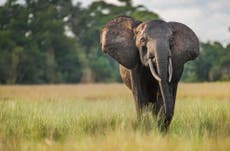Fat dormouse gets stuck in bird feeder
Image of chubby creature symbolises ‘big 2020 energy’, according to social media users

Your support helps us to tell the story
From reproductive rights to climate change to Big Tech, The Independent is on the ground when the story is developing. Whether it's investigating the financials of Elon Musk's pro-Trump PAC or producing our latest documentary, 'The A Word', which shines a light on the American women fighting for reproductive rights, we know how important it is to parse out the facts from the messaging.
At such a critical moment in US history, we need reporters on the ground. Your donation allows us to keep sending journalists to speak to both sides of the story.
The Independent is trusted by Americans across the entire political spectrum. And unlike many other quality news outlets, we choose not to lock Americans out of our reporting and analysis with paywalls. We believe quality journalism should be available to everyone, paid for by those who can afford it.
Your support makes all the difference.The photo of a tubby dormouse trapped - but not unhappily - inside a bird feeder has delighted Britons, many of whom feel they could relate to the small animal while in lockdown.
The dormouse had squeezed itself into the cylindrical feeder on the Isle of Wight to gorge himself on the seed mix inside and plump up for hibernation.
But it fell asleep and became stuck in the container, and was only set free after a resident spotted it and called the Hampshire Dormouse Group for advice.
The group told the resident to ease the roly poly rodent out of the feeder and release it into a hedgerow.
According to the BBC, it is thought the chubby creature may have got into the feeder on Monday night, before it was spotted dozing inside it on Tuesday afternoon, apparently unperturbed by its predicament.
Dormice thrive in the Isle of Wight due to the number of hedgerows and a lack of grey squirrels they would otherwise have to compete with for food.
A picture of the drowsy dormouse shared on Twitter by wildlife charity, People’s Trust for Endangered Species, quickly went viral as many people found it endearing.
Some said it was a “mood”, indicating that the dormouse’s entrapment akin to being in lockdown.
One person said the image was: “me in mouse form”, while another said it was: “Big 2020 energy”.
Another person said: “After eight months of lockdown, I know how it feels…”
Catherine Hadler, from the Hampshire Dormouse Group, said: “Everyone loves a chubby dormouse - it’s quite unusual to see them during the day.
“He was plumping up nicely for hibernation. Safe to say this fatty will survive hibernation just fine.”
She urged people to register sightings of dormice online to help with conservation efforts, as the UK’s native hazel dormouse population has declined by half since 2000 due to a loss of habitat.
“They use hedgerows and scrub and woods as their 'corridors' as they are arboreal so require some kind of tree or scrub vegetation to move via," she told The Independent.
"When these get fragmented, such as hedgerows destroyed by development or huge farming fields with no hedgerow connectivity, the populations cannot move around and a population may get isolated and die out or lose its genetic diversity.
“Expansion of human development is a huge one here as often developers can clear areas of woodland or scrub on the basis that they plant few sapling hedgerows or trees.
“This is useless to any current populations that resided within the cleared woodland as tiny saplings will do nothing to support dormice for many years. It's a joke."
According to a report by the People’s Trust for Endangered Species, dormice are considered “vulnerable” to extinction under Red List criteria, but there are signs their decline has been slowing in the past decade.




Join our commenting forum
Join thought-provoking conversations, follow other Independent readers and see their replies
Comments